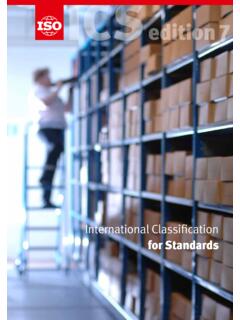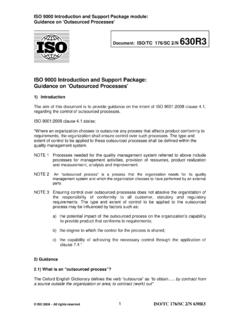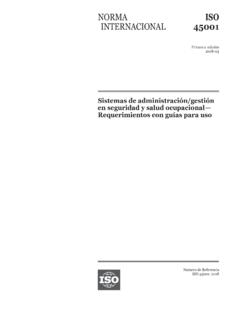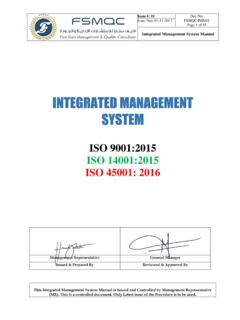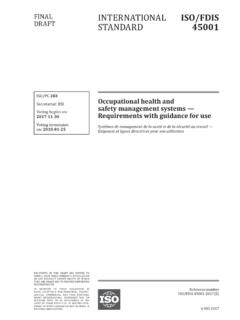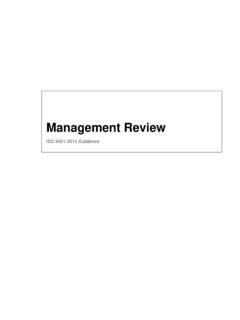Transcription of ISO 14001
1 ISO 14001 . ISO 14001 . Key benefits ISO 14001 is an internationally agreed standard that sets out the requirements for an environmental management system. It helps organizations improve their environmental performance through more efficient use of resources and reduction of waste, gaining a competitive advantage and the trust of stakeholders. What is an environmental management system ? An environmental management system helps organizations identify, manage, monitor and control their environmental issues in a holistic manner. Other ISO standards that look at different types of management systems, such as ISO 9001 for quality management and ISO 45001 for occu- pational health and safety, all use a High- Level Structure. This means that ISO 14001 . can be integrated easily into any existing ISO.
2 Management system. ISO 14001 is suitable for organizations of all types and sizes, be they private, not-for-profit or governmental. It requires that an organiza- tion considers all environmental issues rel- evant to its operations, such as air pollution, water and sewage issues, waste management, soil contamination, climate change mitiga- tion and adaptation, and resource use and efficiency. Like all ISO management system standards, ISO 14001 includes the need for continual improvement of an organization's systems and approach to environmental concerns. The standard has recently been revised, with key improvements such as the increased prominence of environmental management within the organization's strategic planning processes, greater input from leadership and a stronger commitment to proactive initiatives that boost environmental performance.
3 Encourage better environmental performance of suppliers. What benefits will it bring to my business or organization ? There are many reasons why an organization should take a strategic approach to improving its environmental performance. Users of the standard have reported that ISO 14001 helps : Demonstrate compliance with current and future statutory and regulatory requirements Increase leadership involvement and engagement of employees Improve company reputation and the confidence of stakeholders through strategic communication Achieve strategic business aims by incorporating environmental issues into business management Provide a competitive and financial advantage through improved efficiencies and reduced costs Encourage better environmental performance of suppliers by integrating them into the organization's business systems Should I be certified to ISO 14001 ?
4 Accredited certification to ISO 14001 is not a requirement, and organizations can reap many of the benefits from using the standard without going through the accredited certification process. However, third-party certification . ISO does where an independent certification body audits your practices against the requirements of the standard is not perform a way of signalling to your buyers, customers, suppliers and other stake- certification. holders that you have implemented the standard properly. What's more, for some organizations, it helps to show how they meet regulatory or contractual requirements. Although we develop and publish standards, ISO does not perform cer- tification. For more information about the certification process and how to find a certification body, please visit the certification section on our Web- site ( ).
5 Examples of success with ISO 14001 . Organizations using ISO 14001 have found success across a range of areas, including reduced energy and water con- sumption, a more systematic approach to legal compliance and an improved overall environmental performance. Premier Foods Enhancing relationships with stakeholders and staff Since 2001, we have used ISO 14001 to make big improvements such as increasing our organization's recycling rate. We have now been at zero landfill since March 2013. and are recycling and reusing 100 % of our site wastes. We have continued to improve our relationship with neighbours because we have the processes in place to respond quickly to any concerns. Among other benefits, our processes and the appoint- ment of Green Matters Champions ensure that staff are environmentally engaged and aware of the site's potential impact on the environment.
6 Richard Giles Premier Foods, UK. UPCON Corporation Boosting confidence and competitivity UPCON provides services to lift up sunken concrete floors using its unique UPCON method. Achieving certification to ISO 14001 in 2008 allowed us to document effectively the details of our method for all staff to share and standardize the quality of work at every site. In addition to boosting our competitiveness through more accurate quality control, ISO 14001 also strengthens our confidence in our method by dem- onstrating that it produces 90 % less CO2 emissions when compared to concrete replacement. What's more, since our certification, staff engagement and motivation have increased, safe in the knowledge that they are contributing positively to the environ- ment through our products and services.
7 Nobukazu Matsudo UPCON, Japan International Organization for Standardization ISO Central Secretariat Chemin de Blandonnet 8. Case Postale 401. CH 1214 Vernier, Geneva Switzerland ISO, 2015. All rights reserved ISBN 978-92-67-10647-2.


